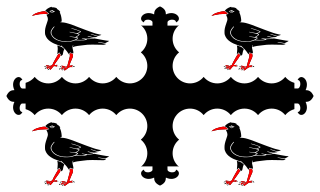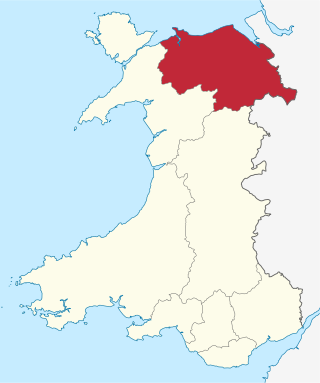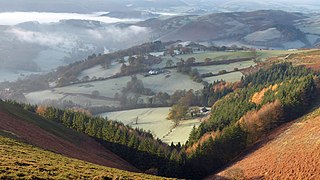
Flintshire is a county in the north-east of Wales. It borders the English ceremonial counties of Merseyside and Cheshire, across the Dee Estuary to the north and by land to the east respectively, Wrexham County Borough to the south, and Denbighshire to the west. Connah's Quay is the largest town, while Flintshire County Council is based in Mold.

Until 1974, Flintshire, also known as the County of Flint, was an administrative county in the north-east of Wales, later classed as one of the thirteen historic counties of Wales.

Clwyd is a preserved county of Wales, situated in the north-east corner of the country; it is named after the River Clwyd, which runs through the area. To the north lies the Irish Sea, with the English ceremonial counties of Cheshire to the east and Shropshire to the south-east. Powys and Gwynedd lie to the south and west respectively. Clwyd also shares a maritime boundary with Merseyside along the River Dee. Between 1974 and 1996, a slightly different area had a county council, with local government functions shared with six district councils. In 1996, Clwyd was abolished, and the new principal areas of Conwy County Borough, Denbighshire, Flintshire and Wrexham County Borough were created; under this reorganisation, "Clwyd" became a preserved county, with the name being retained for certain ceremonial functions.

The River Dee is a river flowing through North Wales, and through Cheshire, England, in Great Britain. The length of the main section from Bala to Chester is 113 km and it is largely located in Wales. The stretch between Aldford and Chester is within England, and two other sections form the border between the two countries.

The River Mellte is a river in south Wales. It is formed by the confluence of the Afon Llia and the Afon Dringarth. It then flows south through the village of Ystradfellte to Pontneddfechan where it joins with the Nedd Fechan to become the River Neath. The river derives its name from 'mellt' - the Welsh word for 'lightning' - after its tendency to rise and fall rapidly in response to heavy rainfall.

Loggerheads is a village in Denbighshire, Wales on the River Alyn, a tributary of the River Dee.

The Clwydian Range is a series of hills in the north-east of Wales that runs from Llandegla in the south to Prestatyn in the north; the highest point is 554 m (1,818 ft) Moel Famau. The range forms the north-western part of the Clwydian Range and Dee Valley Area of Outstanding Natural Beauty.
Ogof Hesp Alyn was discovered by North Wales Caving Club in 1973 in the Alyn Gorge near Cilcain, Flintshire, Wales. Reaching the end of the cave is a serious commitment involving 24 pitches and the draining of two sumps. The proliferation of short, awkward and muddy pitches appear best suited to be tackled by wire ladders, but in the 1980s a team of divers from the Wessex Caving Club who passed the sumps, concluded that single rope technique was preferable, avoiding the need for excessive numbers of people to carry the equipment. A perpetual siphon has since been used at the first sump which does a good job of keeping the water level relatively low, when working properly.

Rhosesmor is a small village near Mold, Flintshire, in north-east Wales. The village lies near the parishes of Halkyn and Rhes-y-cae. The hamlet of Wern-y-Gaer is encompassed by the boundaries of the village.

Llanarmon-yn-Iâl is a village, and local government community, in Denbighshire, Wales, lying in limestone country in the valley of the River Alyn.

Pantymwyn is a small village just outside Mold in Flintshire, Wales, in the community of Gwernaffield with Pantymwyn.
The Alyn Gorge is a gorge section of the River Alyn north between Loggerheads and Rhydymwyn in Wales. The west side of the valley rises gently to Moel Famau, while the east bank is along parts a cliff with evidence of tram lines and old quarry workings.

Llanferres is a village and community in the county of Denbighshire in Wales. At the 2001 Census the population of the village was recorded as 676, increasing to 827 at the 2011 census.

Maeshafn is a small village in Denbighshire, Wales, near the border with Flintshire.
The Milwr Tunnel is a mine drainage adit running some 10 miles from the hamlet of Cadole near Loggerheads, Denbighshire to Bagillt on the Dee Estuary in North Wales. It was originally built to drain the lead mines beneath Halkyn Mountain, which were plagued with flooding in their lower levels, but enabled the exploitation of new lodes and was variously used for the extraction of lead, zinc and limestone during its working history. It is part of a network of mines, lodes and natural cave systems – the Halkyn United Mines – that extends for up to 100 kilometres, the longest in the United Kingdom.

Eryrys is a village in Denbighshire, Wales, located at approximate grid reference SJ203578, five miles south of Mold. The village is built on the limestone formation of Bryn Alyn and many limestone outcrops can be seen close by. At 355m above sea level, Eryrys is one of a number of villages with a valid claim to be the highest in Wales; others include Bwlchgwyn, Wrexham, and Garn-yr-Erw, Torfaen.

Bryn Alyn is a hill and Site of Special Scientific Interest in Denbighshire, North Wales, and forms part of the Clwydian Range and Dee Valley Area of Outstanding Natural Beauty. Bryn Alyn lies in the community of Llanarmon-yn-Iâl, to the east of the River Alyn, with the valley of Dyffryn Alyn separating it from the main range of the Clwydian hills. At just 408m, Bryn Alyn's significance is not in its height, but in the dramatic west-facing limestone cliffs, which can be seen from the nearby A494 trunk road and from many of the walking routes in the southern Clwydian hills. Areas of natural limestone pavement can be found throughout the upper parts of the hill. The main points of access to Bryn Alyn are from the nearby villages of Llanferres and Eryrys. A nature information board for Bryn Alyn can be found in the layby on the A494 just south of Llanferres, at grid reference SJ188600.

Alyn Valley Woods and Alyn Gorge Caves is a Site of Special Scientific Interest on the border of Flintshire and Denbighshire in north Wales. Most of the site is also designated as the Alyn Valley Woods Special Area of Conservation and the southern part includes Loggerheads Country Park. The SSSI has an area of 190.3 hectares while the SAC covers 168.3 hectares.

Loggerheads Country Park is a country park in the village of Loggerheads, Denbighshire, Wales. The park has a wooded river valley that follows the course of the River Alyn and high cliffs from within the Clwydian Range of mountains, with views of the range's tallest mountain Moel Famau. The park has a visitor centre, woodland walks, and two landmarks—a historic corn mill called Pentre Mill, and a gorge called Devil's Gorge.

The Clwydian Range and Dee Valley is a designated Area of Outstanding Natural Beauty located in north-east Wales, covering the Clwydian Range, and the valley of the River Dee.





















